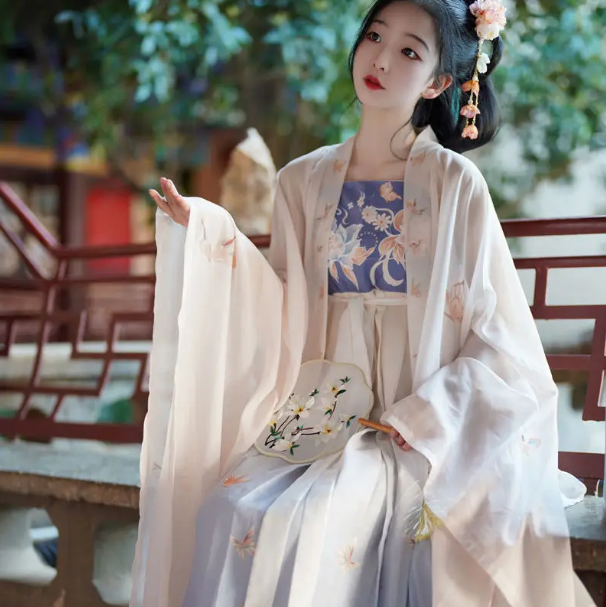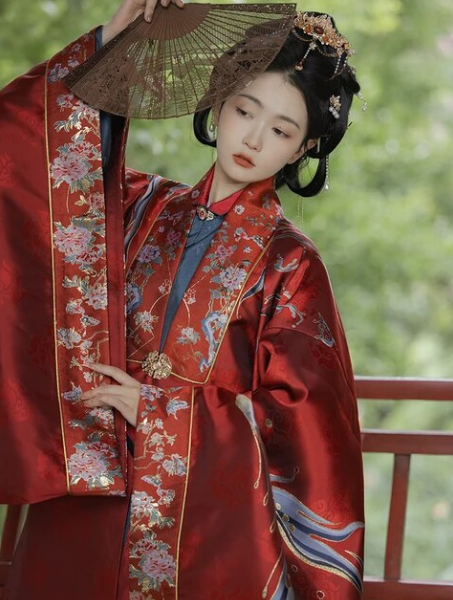Historical Origins and Evolution
The story of Hanfu traces back to the mythological times of Huangdi and Yandi. According to legends, these figures introduced clothing and established the foundation for Hanfu. The real historical journey, however, begins with the Shang Dynasty, marked by the appearance of draped garments.
Early Dynastic Influences
During the Shang Dynasty, people mostly wore simple tunics and rectangular pieces of cloth. The Zhou Dynasty introduced Yi (衣, a draped top garment) and Shang (裳, a lower body skirt). These two items became Hanfu’s basis, evolving over time. The Zhou era also saw the differentiation in clothing to signify social status and profession, a theme recurring in Chinese sartorial history.

Development through the Dynasties
From the Han to the Qing dynasties, Hanfu continually evolved. The Han Dynasty popularized Shenyi (深衣), an integrated tunic-robe, representing unity and modesty. Tang Dynasty’s contribution was vibrant colors and wider sleeves, echoing the period’s prosperous and open culture. During the Song Dynasty, Hanfu became more tailored and delicate, reflecting the refined aesthetics of the time. The Ming Dynasty introduced stand-up collars and straight skirts, emphasizing a neat and straight posture. Each dynasty’s style reflected its ethos and aesthetic values, with variations in sleeves, collars, and embroidery showcasing the rich tapestry of Chinese culture and history.
Traditional Fabrics Used in Hanfu
Hanfu, the classical attire of the Han Chinese, has traditionally used various fabrics. The choice of material varied according to social status, season, and region. The most common materials were silk, cotton, and hemp.
Silk Varieties and Production
Silk, known for its luster and luxurious feel, dominates Hanfu clothing. China’s sericulture produces several silk varieties: Mulberry silk, Tussah silk, Eri silk, and Muga silk. Mulberry silk, coming from silkworms fed on mulberry leaves, stands out for its smoothness and durability, making it highly prized. The production process, from sericulture to weaving, requires precise temperature and humidity control, demanding significant time and skill. This detailed process ensures the high quality and value of silk in traditional Chinese culture.
Cotton and Hemp
Cotton and hemp serve as more breathable, comfortable alternatives to silk, ideal for everyday wear. Cotton gained popularity during the Southern and Northern Dynasties, especially among common people. It’s less expensive than silk and easier to maintain. Hemp, known for its strength and durability, suits summer wear due to its lightweight and moisture-wicking properties. Both cotton and hemp fabrics demonstrate the pragmatic aspect of ancient Chinese textile choices, balancing aesthetics with everyday functionality. Hanfu made from these materials typically displays simpler designs, emphasizing comfort and practicality.
Color Significance and Dyeing Techniques
Color in Hanfu not only adds beauty but also conveys deep symbolic meanings. Ancient Chinese dynasties used colors to represent philosophical and cultural ideas, and the dyeing techniques employed natural sources to achieve these vibrant hues.
Symbolism of Colors in Ancient China
Each color in Hanfu holds specific symbolism. Red, revered as a symbol of good fortune and joy, frequently appears in festivals and weddings. Yellow, once reserved for the emperor, represents power and prestige. Blue and green reflect growth, harmony, and purity, often used in daily wear. Black signifies solemnity and respect, making it common in formal attire. White, traditionally a color of mourning, also denotes purity and simplicity. These colors not only dress the body but also express societal values and beliefs.
Natural Dyes and Their Methods
Ancient Chinese artisans used natural dyes extracted from plants, minerals, and even insects. Indigo, extracted from plants, produces rich blues. The vibrant red comes from madder root or the crushed bodies of the cochineal insect. Turmeric provides a brilliant yellow, while various tree barks and leaves offer greens and browns. The dyeing process involved steeping the fabric in these dye solutions, often requiring multiple immersions and a careful control of temperature and time to ensure the richness and durability of the color. This method, though time-consuming, highlighted the dedication to producing textiles of high quality and profound cultural significance.
Patterns and Embellishments
Patterns and embellishments in Hanfu aren’t just decorative; they carry rich meanings and reflect the intricate craftsmanship of traditional Chinese textile art. From embroidery to weaving, these details tell stories and uphold cultural values.
Traditional Patterns and Their Meanings
Patterns in Hanfu often draw from nature and mythology. Dragons, symbolizing power and authority, commonly appear in imperial garments. The phoenix, another frequent motif, denotes grace and virtue, often associated with femininity. Lotus flowers, representing purity and enlightenment, are popular in both male and female garments. Clouds symbolize good fortune and celestial power, while geometric patterns can signify balance and stability. These designs, deeply rooted in Chinese philosophy and symbolism, impart profound meanings to Hanfu garments.
Embroidery, Painting, and Weaving Techniques
The artistry in Hanfu can be seen in its embroidery, painting, and weaving techniques. Embroidery, involving intricate needlework, adds elegance and color. Famous styles include Su embroidery, known for its delicacy, and Shu embroidery, celebrated for its vividness. Painting on fabric introduces artistic scenes and landscapes, a skill requiring both artistic talent and technical precision. Weaving, particularly brocade and jacquard, creates patterns integrated into the fabric itself, showcasing the high level of skill and attention to detail of Chinese weavers. These techniques not only enhance the garment’s visual appeal but also exhibit the wearer’s social status and aesthetic taste.
Hanfu Styles and Accessories
Hanfu, with its rich history and evolution, exhibits a variety of styles influenced by geography and time. Complementing these styles are accessories, including jewelry and headdresses, which add further cultural significance and beauty to the attire.
Different Styles Across Regions and Eras
Hanfu styles vary greatly across different Chinese regions and historical periods. In the north, garments are typically heavier and simpler to suit the colder climate. Southern styles, influenced by warmer weather, often feature lighter, more delicate fabrics and vibrant patterns. During the Tang Dynasty, Hanfu was characterized by its broad sleeves and round collars, reflecting the era’s openness and cosmopolitanism. The Ming Dynasty preferred stand-up collars and straight silhouettes, emphasizing a more reserved and orderly aesthetic. These varying styles not only represent the fashion of their times but also tell stories of historical shifts and cultural exchanges.

Coordinating Accessories (Jewelry, Headdresses, etc.)
Accessories are integral to Hanfu, completing and accentuating the outfit. Jewelry such as jade pendants, beaded necklaces, and intricate hairpins adds elegance and status symbols. Headdresses, ranging from simple hairbands in the Song Dynasty to elaborate phoenix crowns in the Ming Dynasty, signify marital status and social hierarchy. Fans, both practical and decorative, often bear poetic inscriptions and paintings, reflecting the user’s literary refinement. These accessories, while serving decorative purposes, also adhere to strict traditional codes and etiquette, showcasing the richness and depth of Chinese cultural heritage.
Modern Adaptations and Influences
The resurgence of Hanfu in modern times reflects not just a nostalgic revival but also an adaptation to contemporary tastes and technologies. Designers and enthusiasts blend traditional motifs with modern fabrics and styles, integrating Hanfu into current fashion and cultural events.
Contemporary Fabric and Design Innovations
Modern Hanfu designers often experiment with new fabrics like polyester blends, which offer ease of maintenance and cost-effectiveness compared to traditional silk. Innovations in design include adding zippers for convenience, integrating Western-style cuts, or modifying the length for practicality in daily wear. These adaptations make Hanfu more accessible and versatile, appealing to a broader audience while maintaining its cultural essence.
Hanfu in Modern Fashion and Cultural Events
Today, Hanfu isn’t just a historical costume; it has woven itself into various aspects of contemporary culture. It regularly appears in fashion shows, symbolizing a fusion of ancient heritage with modern aesthetics. Cultural festivals and events, such as the Duanwu (Dragon Boat) Festival and Hanfu parades, often feature these garments, celebrating Chinese history and identity. Online platforms and social media also play a crucial role in popularizing Hanfu among younger generations, inspiring a renewed interest in traditional Chinese culture and fashion.







